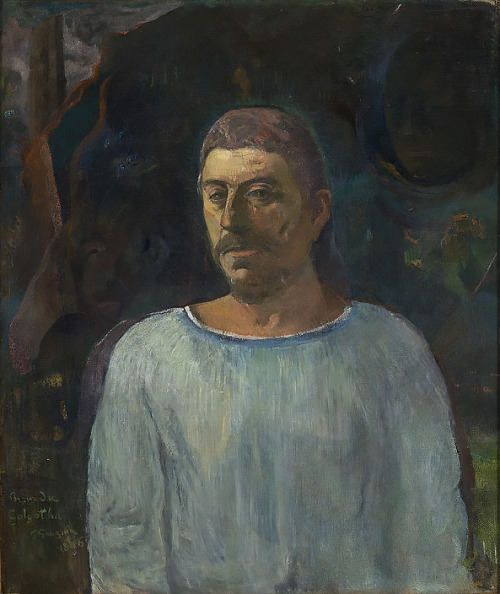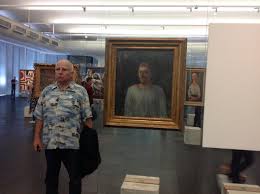Paul Gauguin – “Self-portrait. Near Golgotha ”
Look around the main image and, when it comes to your writing, it will be more productive perhaps for less predictable. By concentrating on the margins, you will be able to illuminate an increasingly personalized spotlight. For example, in Paul Gauguin’s “Near Golgotha”, this is relatively straightforward. On purpose, and although in no less paradoxical way, the painter wishes to focus the contour as much, or even more, than his own self-portrait. The multinaturalist world – which Gauguin has discovered in his travels and residence in Oceania – and his ego or identity in its most radical trance (he is, like Christ, on the way to Golgotha) can no longer be dissociated; one can no longer be conceived without the other. Furthermore, the observer’s discovery and complicity with this epiphany –that of symmetry: the human cosmos– is destined for the whole painting. And, therefore, the theme of it could not be that of pain, farewell or death. But, on the contrary, and as in the poetry of César Vallejo, the welcome to another life that already exists, but before which we cannot smile because it is something too new or unpublished. Example:
No. 534 (“Self-portrait”)
About trimming her light robe
another robe peeks out.
Coarser and darker too.
Some other lamb.
Heaven-chorus
of evasive policemen:
masks, naked torsos,
folds, dull drums.
Multiple looks.
A dumb eye.
A deep scar.
A mouth.
A long and patient wait.
Breasts and arms
still strong.
He’s been dead for days.
The birds flew away
through him.
The night and the undergrowth
raffled very easy
that door half open.
Which one of us goes
Golgotha road?
Mira alrededor de la imagen protagónica y, en lo que se refiere a tu escritura, ésta será más productiva acaso por menos previsible. Concentrándote en los márgenes, acertarás a iluminar un foco cada vez más personalizado. Por ejemplo, en “Cerca al Gólgota” de Paul Gauguin, esto es relativamente sencillo. Adrede, y aunque de modo no menos paradójico, el pintor desea focalizar el contorno tanto, o incluso más, que su propio autoretrato. El mundo multinaturalista –el cual Gauguin ha descubierto en sus viajes y residencia en Oceanía– y su yo o identidad en su trance más radical (se halla, como Cristo, camino del Gólgota) no pueden ya disociarse; no pueden ya concebirse el uno sin el otro. Es más, al descubrimiento y complicidad del observador con esta epifanía –la de la simetría: el cosmos huamano– está destinado todo el cuadro. Y, por lo tanto, la temática del mismo no podría ser la del dolor, la despedida o la muerte. Sino, por el contrario, y tal como en la poesía de César Vallejo, la bienvenida a otra vida que desde ya existe, pero ante la cual no alcanzamos a sonreír porque resulta algo demasiado nuevo o inédito. Ejemplo:
Núm. 534 (“Autorretrato”)
Sobre el recorte de su túnica clara
se otea otra túnica.
Más burda y también más oscura.
Algún otro cordero.
Cielo-coro
de evasivos polizontes:
máscaras, torsos desnudos,
pliegues, tambores sordos.
Múltiples miradas.
Un ojo mudo.
Una honda cicatriz.
Una boca.
Una larga y paciente espera.
Los pechos y los brazos
fuertes todavía.
Hace días que ha muerto.
Los pájaros volaron
a través de él.
La noche y la maleza
sortearon muy fácil
aquella puerta semi abierta.
¿Cuál de todos nosotros va
camino del Gólgota?
ARTÍCULO RELACIONADO:
Granados, Pedro (2017). “Paul Gauguin y César Vallejo: Una curaduría trasatlántica”. En: Pedro Granados, César Vallejo: Tiempo de opacidad, Cap. V. Rio Branco, Brasil: Nepan. 82-93.


